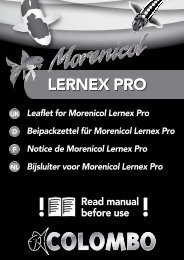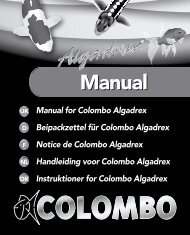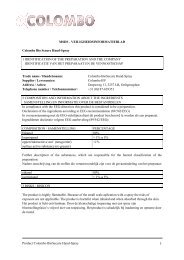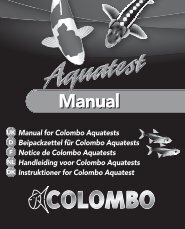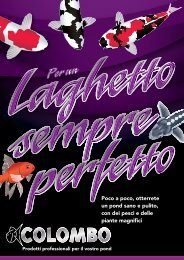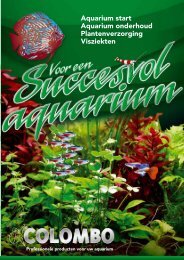ALPAREX® ALPAREX® ALPAREX® - Colombo.nl
ALPAREX® ALPAREX® ALPAREX® - Colombo.nl
ALPAREX® ALPAREX® ALPAREX® - Colombo.nl
Erfolgreiche ePaper selbst erstellen
Machen Sie aus Ihren PDF Publikationen ein blätterbares Flipbook mit unserer einzigartigen Google optimierten e-Paper Software.
7<br />
Information: White spot is caused by Ichtyophthirius multifiliis. This disease usually<br />
occurs when the natural resistance of fish is reduced or compromised. Examples<br />
of such circumstances include transportation, overcrowding, water changes<br />
or the addition of new fish.<br />
Affected fish show white spots on their skin, 0,1 to 1mm in size. These spots can<br />
be separate or clustered. The fish chafe their skin on plants or rocks and may<br />
sometimes ‘rock’ back and forth in the water. After major loss of (breathing) skin<br />
surface or when the gills are affected, shortness of breath sets in and eventually<br />
the fish will die.<br />
Fungal Infection (most caused by Saprolegnia) are marked by the appearance<br />
of greyish white, cotton-like growths on the skin and/or gills. The fungus grows<br />
on the skin surface, but can also penetrate to affect muscles and internal organs.<br />
These cases often prove to be fatal.<br />
Itching can be caused by several parasites. Examples are: Trichodina, Ichtyobodo<br />
and Chilodonella, as do Gyrodactylus (Skin flukes) and Dactylogyrus (gill flukes).<br />
These are flat suckerworms, approx. 0,3-0,5 mm in size. The skin of fish serves as<br />
the main barrier against pathogens and infection by one parasite can open the<br />
way for others.<br />
There are often several sorts of parasites present on the skin, and an infection<br />
can cause excessive production of slime resulting in a greyish white layer on the<br />
surface of the skin. This is easily detected on the eyes, or by looking at the fish<br />
from an angle. When the condition deteriorates, red spots appear, the gills swell<br />
and breathing becomes faster. Seriously affected fish tend to be listless: they lie<br />
on the bottom of the pond or chafe themselves on rocks or plants.<br />
Morenicol Alparex contains substances which act against the above named infections.<br />
Moreover, it is a disinfectant against secondary bacteria infections. When<br />
the itching continues after the treatment with Alparex, it’s recommended to treat<br />
the pond again after 14 days with Morenicol Lernex. A specific product against<br />
skin and gill flukes, anchor worms, leeches and fish lice.<br />
© 13-01-2012. <strong>Colombo</strong> B.V. All or parts of these text may not be reproduced<br />
or publicly disclosed by way of printing, photocopying, microfilming or by other<br />
means without written permission of the author.



